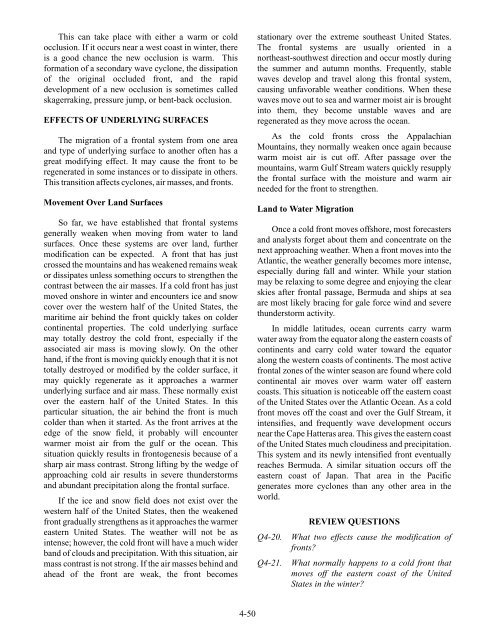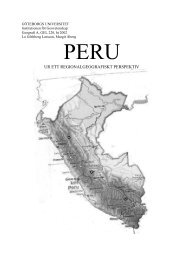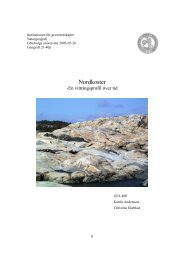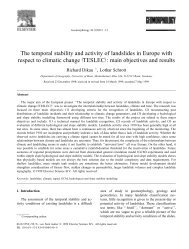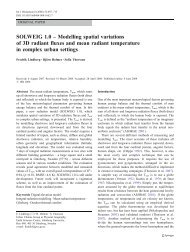AIR MASSES AND FRONTS
AIR MASSES AND FRONTS
AIR MASSES AND FRONTS
Create successful ePaper yourself
Turn your PDF publications into a flip-book with our unique Google optimized e-Paper software.
This can take place with either a warm or cold<br />
occlusion. If it occurs near a west coast in winter, there<br />
is a good chance the new occlusion is warm. This<br />
formation of a secondary wave cyclone, the dissipation<br />
of the original occluded front, and the rapid<br />
development of a new occlusion is sometimes called<br />
skagerraking, pressure jump, or bent-back occlusion.<br />
EFFECTS OF UNDERLYING SURFACES<br />
The migration of a frontal system from one area<br />
and type of underlying surface to another often has a<br />
great modifying effect. It may cause the front to be<br />
regenerated in some instances or to dissipate in others.<br />
This transition affects cyclones, air masses, and fronts.<br />
Movement Over Land Surfaces<br />
So far, we have established that frontal systems<br />
generally weaken when moving from water to land<br />
surfaces. Once these systems are over land, further<br />
modification can be expected. A front that has just<br />
crossed the mountains and has weakened remains weak<br />
or dissipates unless something occurs to strengthen the<br />
contrast between the air masses. If a cold front has just<br />
moved onshore in winter and encounters ice and snow<br />
cover over the western half of the United States, the<br />
maritime air behind the front quickly takes on colder<br />
continental properties. The cold underlying surface<br />
may totally destroy the cold front, especially if the<br />
associated air mass is moving slowly. On the other<br />
hand, if the front is moving quickly enough that it is not<br />
totally destroyed or modified by the colder surface, it<br />
may quickly regenerate as it approaches a warmer<br />
underlying surface and air mass. These normally exist<br />
over the eastern half of the United States. In this<br />
particular situation, the air behind the front is much<br />
colder than when it started. As the front arrives at the<br />
edge of the snow field, it probably will encounter<br />
warmer moist air from the gulf or the ocean. This<br />
situation quickly results in frontogenesis because of a<br />
sharp air mass contrast. Strong lifting by the wedge of<br />
approaching cold air results in severe thunderstorms<br />
and abundant precipitation along the frontal surface.<br />
If the ice and snow field does not exist over the<br />
western half of the United States, then the weakened<br />
front gradually strengthens as it approaches the warmer<br />
eastern United States. The weather will not be as<br />
intense; however, the cold front will have a much wider<br />
band of clouds and precipitation. With this situation, air<br />
mass contrast is not strong. If the air masses behind and<br />
ahead of the front are weak, the front becomes<br />
4-50<br />
stationary over the extreme southeast United States.<br />
The frontal systems are usually oriented in a<br />
northeast-southwest direction and occur mostly during<br />
the summer and autumn months. Frequently, stable<br />
waves develop and travel along this frontal system,<br />
causing unfavorable weather conditions. When these<br />
waves move out to sea and warmer moist air is brought<br />
into them, they become unstable waves and are<br />
regenerated as they move across the ocean.<br />
As the cold fronts cross the Appalachian<br />
Mountains, they normally weaken once again because<br />
warm moist air is cut off. After passage over the<br />
mountains, warm Gulf Stream waters quickly resupply<br />
the frontal surface with the moisture and warm air<br />
needed for the front to strengthen.<br />
Land to Water Migration<br />
Once a cold front moves offshore, most forecasters<br />
and analysts forget about them and concentrate on the<br />
next approaching weather. When a front moves into the<br />
Atlantic, the weather generally becomes more intense,<br />
especially during fall and winter. While your station<br />
may be relaxing to some degree and enjoying the clear<br />
skies after frontal passage, Bermuda and ships at sea<br />
are most likely bracing for gale force wind and severe<br />
thunderstorm activity.<br />
In middle latitudes, ocean currents carry warm<br />
water away from the equator along the eastern coasts of<br />
continents and carry cold water toward the equator<br />
along the western coasts of continents. The most active<br />
frontal zones of the winter season are found where cold<br />
continental air moves over warm water off eastern<br />
coasts. This situation is noticeable off the eastern coast<br />
of the United States over the Atlantic Ocean. As a cold<br />
front moves off the coast and over the Gulf Stream, it<br />
intensifies, and frequently wave development occurs<br />
near the Cape Hatteras area. This gives the eastern coast<br />
of the United States much cloudiness and precipitation.<br />
This system and its newly intensified front eventually<br />
reaches Bermuda. A similar situation occurs off the<br />
eastern coast of Japan. That area in the Pacific<br />
generates more cyclones than any other area in the<br />
world.<br />
REVIEW QUESTIONS<br />
Q4-20. What two effects cause the modification of<br />
fronts?<br />
Q4-21. What normally happens to a cold front that<br />
moves off the eastern coast of the United<br />
States in the winter?


